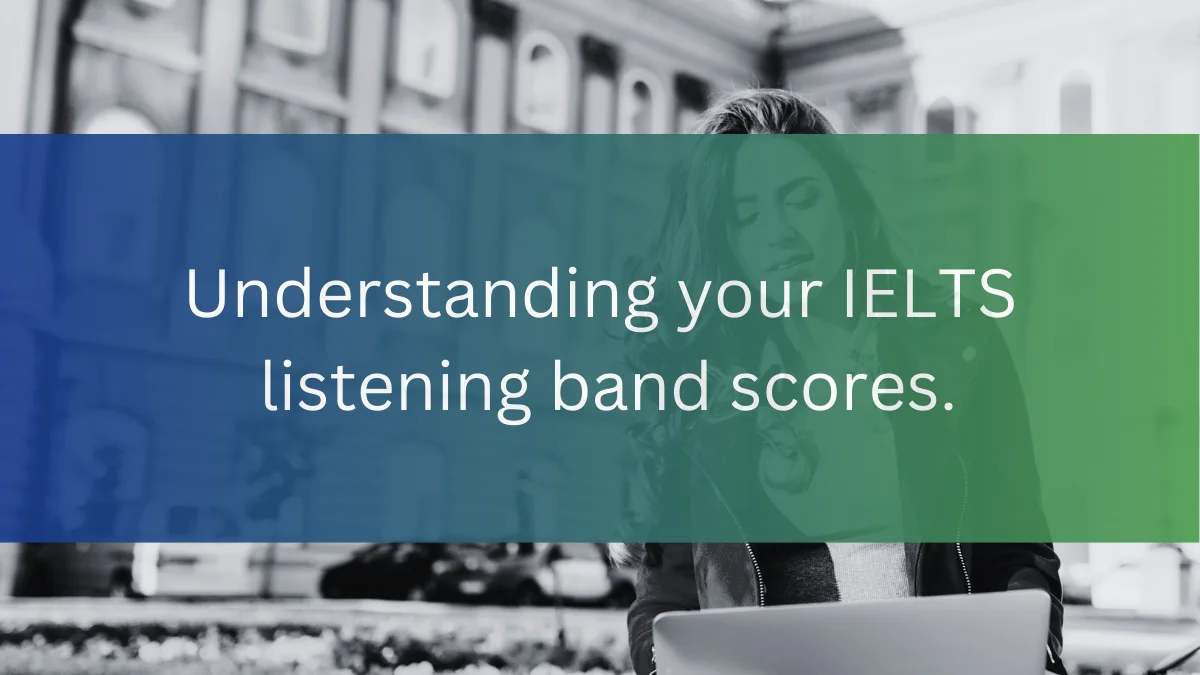Understanding IELTS Listening Band Scores
The IELTS (International English Language Testing System) is one of the most recognised and widely accepted English proficiency tests globally. It assesses a candidate’s abilities in listening, reading, writing, and speaking. However, understanding how IELTS band scores are calculated and what they mean can be a bit challenging for test-takers. This guide will help you decode the IELTS band scores, particularly focusing on the IELTS listening band score and how it correlates with other sections.

What is an IELTS Band Score?
An IELTS band score ranges from 1 to 9 for each section of the test. The scores reflect the level of proficiency in English, with 1 being the lowest and 9 the highest. Here’s a quick overview of what each band score signifies:
- Band 9: Expert User
- Band 8: Very Good User
- Band 7: Good User
- Band 6: Competent User
- Band 5: Modest User
- Band 4: Limited User
- Band 3: Extremely Limited User
- Band 2: Intermittent User
- Band 1: Non-User
- Band 0: Did not attempt the test
The Importance of the IELTS Listening Band Score
The IELTS listening band score is crucial as it forms a significant part of your overall IELTS score. Listening is often considered one of the more challenging sections due to the variety of accents and the need for quick comprehension. Understanding your IELTS listening band score is vital for planning and improving your performance.
How is the IELTS Listening Band Score Calculated?
The IELTS listening band score is derived from your performance on 40 questions. Each correct answer is awarded one mark, and your total score out of 40 is then converted into a band score. Here’s a rough breakdown of how your raw score might translate:
- 39-40 correct answers: Band 9
- 37-38 correct answers: Band 8.5
- 35-36 correct answers: Band 8
- 32-34 correct answers: Band 7.5
- 30-31 correct answers: Band 7
- 26-29 correct answers: Band 6.5
- 23-25 correct answers: Band 6
- 18-22 correct answers: Band 5.5
- 16-17 correct answers: Band 5
- 13-15 correct answers: Band 4.5
- 10-12 correct answers: Band 4
- 6-9 correct answers: Band 3
- 3-5 correct answers: Band 2
- 1-2 correct answers: Band 1
IELTS Academic Listening Score Chart
For those taking the IELTS Academic test, understanding the IELTS academic listening score chart is essential. The chart provides a clear indication of how many correct answers you need to achieve your desired band score. Here’s an overview:
- Band 9: 39-40 correct answers
- Band 8: 35-36 correct answers
- Band 7: 30-31 correct answers
- Band 6: 23-25 correct answers
- Band 5: 16-17 correct answers
This chart helps candidates set realistic goals and prepare accordingly.
IELTS Band Score Chart for Academic Reading and Listening
The IELTS band score chart for academic reading and listening is slightly different. While the listening section has a uniform score chart, the reading section varies slightly depending on whether you are taking the Academic or General Training test.
For Academic Reading:
- Band 9: 39-40 correct answers
- Band 8: 35-36 correct answers
- Band 7: 30-31 correct answers
- Band 6: 23-25 correct answers
For General Training Reading:
- Band 9: 40 correct answers
- Band 8: 37-38 correct answers
- Band 7: 34-35 correct answers
- Band 6: 30-31 correct answers
The band score chart for both sections allows candidates to track their progress and understand how their raw scores convert into band scores.
Understanding the IELTS Listening Band Score Chart
The IELTS listening band score chart is designed to help candidates easily understand how their performance translates into a band score. It is a vital tool for those looking to improve their IELTS listening band score. By using this chart, candidates can set target scores, understand their weaknesses, and focus on specific areas that need improvement.
The Relationship Between IELTS Listening and Reading Band Scores
Your overall IELTS band score is an average of your scores in listening, reading, writing, and speaking. However, the IELTS listening and reading band scores are particularly critical as they often weigh heavily in the overall score. A strong performance in these areas can significantly boost your final score.
IELTS Listening Band Score Calculator
A handy tool for test-takers is the IELTS listening band score calculator. This calculator allows you to input your raw score (the number of correct answers) and instantly get your band score. It’s a convenient way to predict your listening band score before receiving your official results.
Differences Between IELTS Academic and General Listening Band Scores
Understanding the differences between the IELTS academic listening band score and the IELTS general listening band score is crucial. While the listening section’s format remains the same, the score requirements might differ slightly based on the test version you are taking.
Tips to Improve Your IELTS Listening Band Score
Improving your IELTS listening band score requires consistent practice and strategic preparation. Here are some tips:
- Practice with different accents: Since the listening test features various English accents, it can be beneficial to practice with Australian, British, and American accents.
- Take mock tests: Regular practice with full-length mock tests will help you get accustomed to the test format and time constraints.
- Focus on weak areas: Use the IELTS listening band score chart to identify your weak areas and concentrate on improving them.
- Develop note-taking skills: Jotting down key points during the listening test can help you remember the information.
- Stay calm and focused: Nervousness can lead to mistakes. Practice relaxation techniques to stay calm during the test.
Common Pitfalls in the IELTS Listening Section
Understanding common mistakes can help you avoid them and achieve a higher IELTS listening band score:
- Misinterpretation of questions: Ensure you fully understand the questions before answering.
- Inability to follow the audio: Practice active listening to follow the audio without missing crucial information.
- Spelling errors: Incorrect spelling can lead to losing marks, even if the answer is conceptually correct.
- Overlooking instructions: Always follow the instructions carefully, especially regarding word limits.
The Impact of IELTS Listening Band Score on Overall Band Score
Your IELTS listening band score contributes directly to your overall band score. If you’re aiming for a high overall score, focusing on the listening section is essential. A high score in listening can offset lower scores in other sections and help you achieve your desired band score.
Key Strategies for Achieving a High IELTS Listening Band Score
- Understand the format: Familiarize yourself with the different sections of the listening test.
- Time management: Practice managing your time effectively to ensure you can complete all sections without rushing.
- Review your answers: If time permits, review your answers to correct any mistakes.
How to Use the IELTS Listening Band Score Chart for Improvement
The IELTS listening band score chart is not just a tool for understanding your score—it’s a roadmap for improvement. By regularly checking your score against the chart, you can:
- Track your progress: Monitor how your score improves over time.
- Set achievable goals: Aim for gradual improvements rather than drastic changes.
- Focus on specific areas: Use the chart to identify areas that need more attention.
The Role of Practice in Achieving a High IELTS Listening Band Score
Consistent practice is the key to achieving a high IELTS listening band score. The more you practice, the more familiar you become with the test format, the types of questions asked, and the pace of the listening section.
The Influence of IELTS Listening Band Score on Admission Processes
For those applying to universities or colleges, a high IELTS listening band score can be a significant factor in the admission process. Many institutions have minimum band score requirements, and excelling in the listening section can strengthen your application.
FAQs about IELTS Listening Band Scores
- What is the highest IELTS listening band score I can achieve?
- The highest score you can achieve in the listening section is Band 9.
- How many correct answers do I need for a Band 7 in listening?
- You need approximately 30-31 correct answers to achieve a Band 7.
- Can I use the IELTS listening band score calculator for both Academic and General Training?
- Yes, the IELTS listening band score calculator can be used for both versions of the test.
Final Thoughts on IELTS Listening Band Scores
Understanding your IELTS listening band score is crucial for success in the IELTS exam. By using tools like the IELTS listening band score chart and calculator, setting realistic goals, and focusing on consistent practice, you can significantly improve your listening band score.
Ready to achieve your desired IELTS band score? Enrol with IMS Venturi today for personalised IELTS preparation and expert guidance through your admission process. Our experienced mentors are here to help you succeed.






